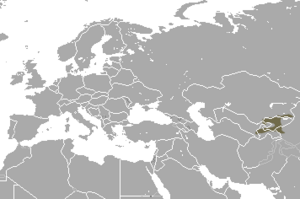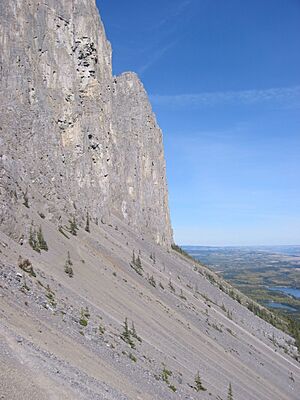Turkestan red pika facts for kids
Quick facts for kids Turkestan red pika |
|
|---|---|
 |
|
| Conservation status | |
| Scientific classification | |
| Genus: |
Ochotona
|
| Species: |
rutila
|
 |
|
| Turkestan red pika range | |
The Turkestan red pika (Ochotona rutila) is a small, furry mammal that belongs to the Ochotonidae family, which also includes rabbits and hares. This pika gets its name from its bright reddish-brown fur, especially noticeable in summer. In winter, its fur turns a lighter brown.
You can find the Turkestan red pika living in the mountains of western Xinjiang, China. It also lives in parts of central Asia, including Kazakhstan, Kyrgyzstan, Tajikistan, and Uzbekistan. Female pikas usually have two litters of young each year, with two to six babies in each litter.
Even though it has a low birth rate, the Turkestan red pika is listed as a species of least concern by the IUCN Red List. This means it's not currently in danger of disappearing. However, in China, it's considered "near-threatened," meaning its population there needs to be watched closely.
Contents
About the Turkestan Red Pika
The Turkestan red pika is one of about 30 different kinds of pikas. A Russian naturalist named Nikolai Alekseevich Severtzov first described this pika in 1873.
For a while, some scientists thought other pikas, like the Chinese red pika and Glover's pika, were just types of the Turkestan red pika. But later, other scientists studied their colors, where they lived (called zoogeography), and the shape of their skulls (called morphology). They found enough differences to say these were all separate species. Today, the Turkestan red pika is recognized as its own unique species, with no different types (subspecies) within it.
What Does It Look Like?
The Turkestan red pika is about 19.6 to 23 cm (7.7 to 9.1 in) long, which is about the length of a large pencil. It weighs between 220 to 320 g (7.8 to 11.3 oz), which is about as much as a can of soda. Its skull is quite large, measuring 4.6 to 5.3 cm (1.8 to 2.1 in).
Its ears are about 2.7 to 2.9 cm (1.1 to 1.1 in) long and are grayish-black on the back. In summer, its fur on its back is a bright reddish-orange. It often has white spots on its neck, sometimes forming a yellowish-white band. The sides of its body have a yellowish-brown tint. The fur on its belly is white or a light yellowish-brown.
In winter, the fur on its back changes to a pale brown. Its belly fur remains white or light yellowish-brown. Its back feet are about 3.6 to 3.9 cm (1.4 to 1.5 in) long.
Unlike many other pikas, the Turkestan red pika is known for being very quiet. It's sometimes called the "silent" pika because it doesn't make alarm calls or songs like other pikas. If it senses danger, it will hide under rocks. It might make a chattering sound, which is similar to the calls of some other pika species. This sound helps warn other pikas nearby.
Where Do They Live?
The Turkestan red pika lives in the mountains of central Asia. This area, known as Turkestan, includes parts of western China (Xinjiang), Kazakhstan, Kyrgyzstan, Tajikistan, and Uzbekistan. It might also be found in northern Afghanistan.
These pikas are "rock-dwelling" animals. This means they prefer to live among talus deposits, which are piles of broken rocks found at the bottom of cliffs. They use these rocks for shelter and to hide from predators.
Even though there are rocky areas at higher elevations, the Turkestan red pika usually lives at moderate heights, typically below 3,000 metres (9,800 ft) above sea level.
Behavior and Life Cycle
The Turkestan red pika is a diurnal species, meaning it is most active during the day. It tends to be more active in the evening than in the morning. These pikas live in family groups, usually made up of an adult male, an adult female, and their young during the breeding season.
There aren't many Turkestan red pikas in one area. About 12 to 20 individuals, or 3 to 3.5 families, live in one hectare (about the size of a soccer field). Different family territories are usually 50 to 100 m (160 to 330 ft) apart, but sometimes they can be closer.
Like other pikas, the Turkestan red pika is a herbivore, meaning it eats plants. They collect plants and store them in piles, often called "haypiles," for food later. Unlike most pikas, they don't usually eat in open grassy areas. Instead, they stay very close to the rocky areas where they live, usually within 2 metres (6 ft 7 in) of the edge of the rocks and plants. They have large areas where they search for food, which helps them find enough to eat even if plants are spread out.
Female pikas have a low number of offspring. During the breeding season, which runs from spring to summer, they usually have two litters. Each litter has about two to six young, with an average of 4.2 babies. The young pikas are not ready to have their own babies in the same summer they are born. For most of the summer, the young pikas stay with their parents and eat the plants their parents have stored. Many of the young pikas also stay with their parents through the following winter. Even though adult males and females share the same home area, they are rarely seen together in the autumn.
One of the main animals that hunts the Turkestan red pika is the stoat (Mustela erminea). Scientists have found pika fur in stoat droppings, showing that stoats often prey on them.
Status and Conservation
Since 1996, the Turkestan red pika has been listed as a species of least concern on the IUCN Red List. This is good news because it means the species is not currently at high risk of extinction. Even though they live in scattered groups, they are found across a wide area where their habitat is suitable. Their population numbers also seem to be stable.
There are no major known threats to the Turkestan red pika. However, their low population density and low birth rates are things that scientists keep an eye on. In the past, these pikas were sometimes trapped for their fur, but this practice has now stopped. As mentioned earlier, Chinese authorities consider the Turkestan red pika to be "near threatened" within China, so efforts are made to protect them there.



